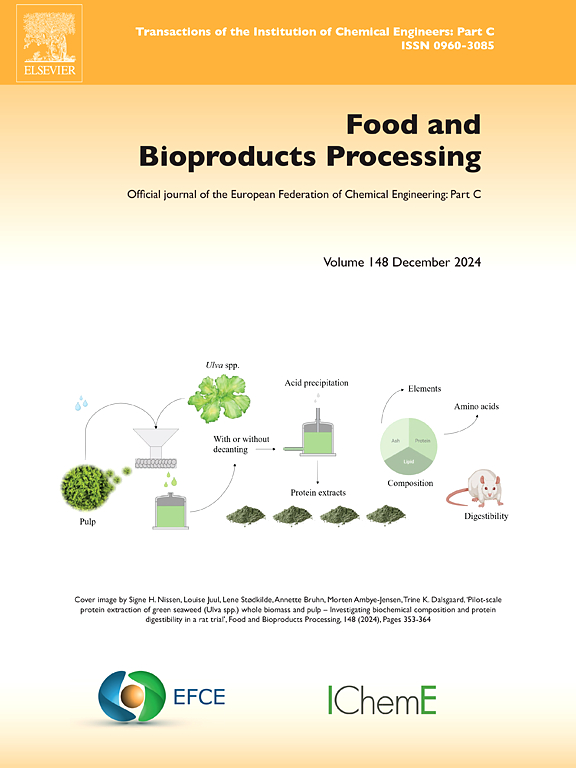A testing procedure for evaluating the steeping quality of incoming corn for the wet-milling process
IF 3.4
2区 农林科学
Q2 BIOTECHNOLOGY & APPLIED MICROBIOLOGY
引用次数: 0
Abstract
A laboratory-scale procedure is proposed to evaluate the steeping quality of yellow dent corn for the wet milling process. The study investigated the effects of steeping temperature, sulfur dioxide (SO2) concentration, initial moisture content of corn grains, and steeping time on the total charge-to-corn mass ratio (Cm) and the starch content (% g/ml) of slurry samples after the first grind, using a central composite design (CCD). A significant negative effect of the initial moisture content, as well as a complex interaction between the factors and the response variables were identified. Two feasible regions of operation were identified for optimal starch granule release, which were confirmed through validation experiments. The wet-milling starch yields achieved (66.85 % – 68.15 % g/g) were comparable to those reported in industrial operations. The region of operation I included initial moisture contents ranging from 12.08 % and 14.54 % w.b, SO2 concentrations between 0.165 % and 0.35 % g/ml, steeping temperatures between 47.5°C and 55°C, and steeping times of 48 h to 50 h. The region of operation II corresponded to initial moisture contents from 12.08 % and 15.50 % w.b, SO2 concentrations between 0.03 % and 0.28 % g/ml, and steeping temperatures between 35°C and 45°C. Favorable operational conditions were successfully recreated, demonstrating the applicability of the proposed procedure and the models obtained.
一种评价湿磨工艺中来料玉米浸泡质量的试验方法
提出了一种实验室规模的方法来评价湿磨工艺中黄凹玉米的浸泡质量。采用中心复合设计(CCD),研究了浸泡温度、二氧化硫(SO2)浓度、玉米粒初始含水量和浸泡时间对第一次研磨后料浆样品总电荷与玉米质量比(Cm)和淀粉含量(% g/ml)的影响。发现了初始含水率的显著负影响,以及各因素与响应变量之间复杂的相互作用。确定了淀粉颗粒最佳释放的两个可行操作区域,并通过验证实验进行了验证。湿磨淀粉得率(66.85 % ~ 68.15 % g/g)与工业生产相当。操作I区域的初始水分含量为12.08 % ~ 14.54 % w.b, SO2浓度为0.165 % ~ 0.35 % g/ml,浸泡温度为47.5℃~ 55℃,浸泡时间为48 h ~ 50 h。操作II区域对应的初始水分含量为12.08 % ~ 15.50 % w.b, SO2浓度为0.03 % ~ 0.28 % g/ml,浸泡温度为35℃~ 45℃。成功地再现了良好的操作条件,证明了所提出的程序和所获得的模型的适用性。
本文章由计算机程序翻译,如有差异,请以英文原文为准。
求助全文
约1分钟内获得全文
求助全文
来源期刊

Food and Bioproducts Processing
工程技术-工程:化工
CiteScore
9.70
自引率
4.30%
发文量
115
审稿时长
24 days
期刊介绍:
Official Journal of the European Federation of Chemical Engineering:
Part C
FBP aims to be the principal international journal for publication of high quality, original papers in the branches of engineering and science dedicated to the safe processing of biological products. It is the only journal to exploit the synergy between biotechnology, bioprocessing and food engineering.
Papers showing how research results can be used in engineering design, and accounts of experimental or theoretical research work bringing new perspectives to established principles, highlighting unsolved problems or indicating directions for future research, are particularly welcome. Contributions that deal with new developments in equipment or processes and that can be given quantitative expression are encouraged. The journal is especially interested in papers that extend the boundaries of food and bioproducts processing.
The journal has a strong emphasis on the interface between engineering and food or bioproducts. Papers that are not likely to be published are those:
• Primarily concerned with food formulation
• That use experimental design techniques to obtain response surfaces but gain little insight from them
• That are empirical and ignore established mechanistic models, e.g., empirical drying curves
• That are primarily concerned about sensory evaluation and colour
• Concern the extraction, encapsulation and/or antioxidant activity of a specific biological material without providing insight that could be applied to a similar but different material,
• Containing only chemical analyses of biological materials.
 求助内容:
求助内容: 应助结果提醒方式:
应助结果提醒方式:


